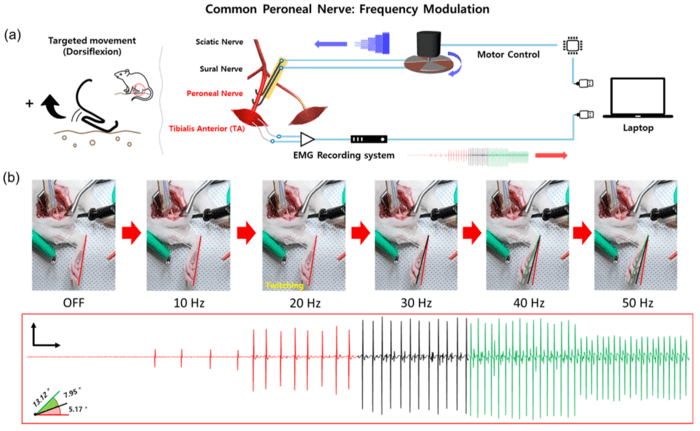□ The research team led by Professor Sanghoon Lee from the Department of Robotics and Mechatronics Engineering at DGSIT (President Yang Kuk) successfully developed a rotation-based triboelectric neuro-stimulator (RoTENS) capable of real-time modulations of stimulus parameters, including current amplitude, frequency, and pulse width.
□ Existing neurostimulators require additional steps when adjusting stimulus parameters in real time owing to the characteristics of its circuit-based system. In particular, changing the stimulus parameters while maintaining charge requires complex calculations and additional processes via electronic devices, resulting in low practicality.
□ Professor Sanghoon Lee’s research team at DGIST modified triboelectric nanogenerators (TENG)[1], which generate electric energy via friction, to a rotation-based design, generating multiple pulses[2] with a single rotation. In addition, various pulses can be modulated for neurostimulation by changing the electrode patterns in the TENG.
□ Owing to the charge-generation mechanism of TENG, RoTENG enables the control of the frequency and pulse width[3] while maintaining a constant charge during rotation, allowing nerve stimulation while controlling stimulus parameters in real time. Furthermore, adjusting the interlayer distance allows for controlling the amplitude of the pulses, indicating that various stimulus parameters (frequency, pulse width, and amplitude) can be controlled.
□ In vivo animal experiments were performed to verify the clinical effectiveness of RoTENS. The physiological responses induced by modulating the stimulus parameters by RoTENS were observed during the stimulation of the right tibial nerve in rats. Varying the frequency (10-50 Hz) allowed the muscle to shift its physiological state smoothly from twitching to fused tetanus. Natural relaxation of the muscle was induced by changing the current amplitude via the distance between the two layers (0-6 mm). These results indicate that RoTENS is sufficient to induce the desired physiological response while creating a wide range of frequencies and amplitudes.
□ Professor Sanghoon Lee (Robotics and Mechatronics Engineering, DGIST) said that preclinical trials with the newly developed neuro-stimulators proves that it is possible to control the stimulus parameters for neural stimulation in real time with rotational energy. We expect that technological advancements and further optimization research will lead to new opportunities and possibilities for the use of TENG as neurostimulators, such as immediate and intuitive sensory feedback to bionic limbs or exoskeletons, rehabilitation, and bioelectric medicine.
This research was supported by a National Research Foundation of Korea grant and Hugo Dynamics Korea Medical Device Development Fund grant. This paper was published by a renownd journal in the field of energy, Nano Energy.
Correspondent author’s email address : hoonw@dgist.ac.kr
[1] Triboelectric nanogenerators (TENG): A nanogenerator used for energy harvesting and sensors from the electric charge generated via triboelectrification and electrostatic induction from the contact between two different materials with different static electricity properties
[2] Pulse: A voltage, current, or wave that creates a large amplitude within a short time period
[3] Pulse width: The time between rising and falling of the pulse where the amplitude is at half
Journal
Nano Energy
DOI
10.1016/j.nanoen.2022.107861
Article Title
Triboelectric neurostimulator for physiological modulation of leg muscle
Article Publication Date
1-Dec-2022

















